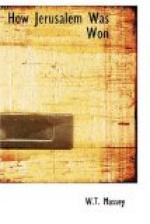New circumstances came to light after the advance was first arranged, and these demanded that the enemy should be driven across the Jordan as soon as possible. General Allenby decided that the operations should be carried out in two phases. The first was an easterly advance to thrust the enemy from his position covering Jericho, to force him across the Jordan, and to obtain control of the country west of the river. The northerly advance to secure the line of the wadi Aujah was to follow. This river Aujah which flows into the Jordan must not be confused with the Auja on the coast already described.
The period of wet weather was prolonged, and the accumulation of supplies of rations and ammunition did not permit of operations commencing before February 19. That they started so early is an eloquent tribute to the hard work of the Army, for the weather by the date of the attack had improved but little, and the task of getting up stores could only be completed by extraordinary exertions. General Chetwode ordered a brigade of the 60th Division to capture Mukhmas as a preliminary to a concentration at that place. On the 19th the Division occupied a front of about fourteen miles from near Muntar, close to which the ancient road from Bethlehem to Jericho passes, through Ras Umm Deisis, across the Jerusalem-Jericho road to Arak Ibrahim, over the great chasm of the wadi Farah which has cliff-like sides hundreds of feet deep, to the brown knob of Ras et Tawil. The line was not gained without fighting. The Turks did not oppose us at Muntar—the spot where the Jews released the Scapegoat—but there was a short contest for Ibrahim, and a longer fight lasting till the afternoon for an entrenched position a mile north of it; Ras et Tawil was ours by nine in the morning. Tawil overlooks a track which has been trodden from time immemorial. It leads from the Jordan valley north-west of Jericho, and passes beneath the frowning height of Jebel Kuruntul with its bare face relieved by a monastery built into the rock about half-way up, and a walled garden on top to mark the Mount of Temptation, as the pious monks believe it to be. The track then proceeds westwards, winding in and out of the tremendous slits in rock, to Mukhmas, and it was probably along this rough line that the Israelites marched from their camp at Gilgal to overthrow the Philistines. On the right of the Londoners were two brigades of the Anzac Mounted Division, working through the most desolate hills and wadis down to the Dead Sea with a view to pushing up by Nebi Musa, which tradition has ascribed as the burial place of Moses, and thence into the Jordan valley. Northward of the 60th Division the 53rd was extending its flank eastwards to command the Taiyibeh-Jericho road, and the Welsh troops occupied Rummon, a huge mount of chalk giving a good view of the Wilderness. This was the position on the night of 19th February.
At dawn on the 20th the Londoners were to attack the Turks in three columns. The right column was to march from El Muntar to Ekteif, the centre column to proceed along the Jerusalem-Jericho road between the highway and the wadi Farah, and the left column was to go forward by the Tawil-Jebel Kuruntul track. The 1st Australian Light Horse Brigade and the New Zealand Mounted Rifles Brigade were, if possible, to make Nebi Musa.




